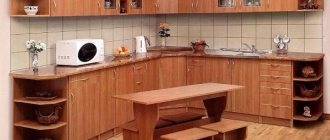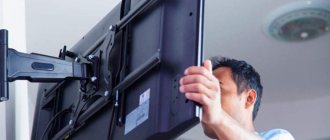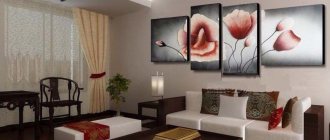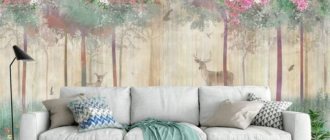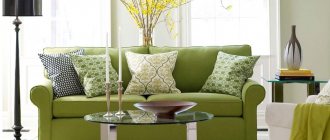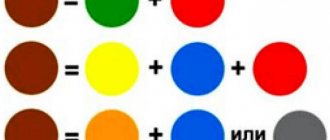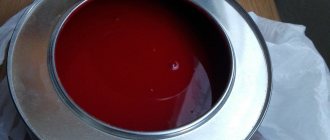What types of fasteners are there according to method of use?
Among the diversity of the construction market, fittings are divided into categories depending on size, material, load capacity, and strength of the base. Craftsmen advise using wooden choppers instead of dowels; this measure will help the bookcase to fall soon. Over time, the tree dries out, in conditions of high humidity, and with temperature changes, it often and greatly changes in size.
Hidden fasteners for shelves to the wall
Often this method of fastening is chosen due to the design features of the room. Installation involves complexity and is rarely used. Hidden fittings are suitable for shelving made of wood, laminated chipboard, and plywood sheets.
These can be rods, bars, plates, hinged loops. The latter imply that first the hinges are attached, screws are screwed into the wall, and then the part is hung. The fixation is not visible, everything is securely hidden.
Rod products distribute the load perfectly. They are placed inside the shelf so that at least 2-5 cm remains to the edge. Often, sections of reinforcing rods, construction studs with threads, and drive-in anchors are used as rods. Depending on the expected weight of things, rods with a thickness of 1 to 1.8 cm are taken.
Concealed mensolo holders are rods that are attached to the back side of the shelf and a bracket for fastening to the wall. This way out of the situation is possible if there are holes inside the shelf without loss of functional qualities.
Multi-level products are successfully mounted on plates that are firmly fixed to the main surface.
When using wooden beams, a sheathing is assembled, on which a shelf is placed on top.
It creates the impression of a floating or floating shelf, weightlessness.
Open fittings, brackets
The easiest installation method is to use open fittings.
Corner brackets are suitable for inserts, withstanding loads of up to 20-40 kg, which depends on the type of fastener.
When an increased load is planned, reinforced parts are taken, with additional jumpers, capable of holding up to 100 kg.
Shelf bracket
If you don’t plan to put a lot on the shelf, decorative corners with a maximum load capacity of 10-30 kg, called mensolo holders, will suffice. This fastener has decorative qualities that complement the interior.
Wooden or metal slats are divided into single-level with a horizontal direction and two-level with a vertical direction.
Reinforced fittings are often used when decorating storage areas inside utility rooms, where increased load is expected. In other cases (in residential premises, offices), decorative holders are suitable.
Necessary materials
For wall shelves you can use a variety of materials:
- GKL. Designers often use plasterboard in interior design, especially if shelves made of this material are assigned one of the main places in the room.
- Tree. Most often used for balcony shelves. Working with it is not difficult, and its mass is small. When used correctly, these shelves can last a very long time.
- Chipboard or chipboard. Moisture-resistant material, withstands temperature changes, wear-resistant.
- Glass. Very common in use. Glass shelves look very fashionable.
- Plastic. The publicly available material, since it is inexpensive, is not susceptible to mold.
- Metal. When working with it, you will definitely need a welding machine.
Then screws are screwed in to a sufficient depth and hinges are placed on them.
If necessary, we make adjustments.
How to choose a mount for different shelves
They are chosen based partly on the preferences of the owners and designers, the main criterion being the functionality of the product. When the choice of the main part is made, select the desired fastener.
Tree
It is convenient to hang wooden products on hidden elements, or put them in wide loops.
Wood products
The installation of wood on forged mensolo holders looks good in the overall classic design style. They can be painted in black, copper or bronze tones for a nice look.
Glass
It is not recommended to drill or cut through glass shelves, so holders with clamps will be the solution. Glass is inserted inside them, pulled together tightly, and the shelf is securely fixed.
A good option with this operating principle is the “pelican”. These holders are represented by two large separate parts located at a distance from each other. A shelf is placed between both parts and tightened to fix it with a common screw.
Glass shelf
Sometimes aluminum horizontal profile slats are used. If the shelves are sandblasted, you can install additional lighting.
Corner products
The shelves located in the corner of the room are attached according to the general principle with the difference that the holders are placed at an angle relative to each other.
This is the main reason why long horizontal brackets are not used - they will intersect and overlap.
Corner model
It is necessary to choose aluminum slats, “pelicans”, or similar fastenings. It is worth remembering that corner parts assume a low load.
Metal
Metal ones are mounted on systems that are frames. They are formed from horizontal and vertical slats to which brackets are attached.
Metal model
A simple model involves lifting a load of up to 60 kg, the reinforcement from below holds up to 120 kg, and the placement of the amplifier at the bottom and top adds stability up to 180 kg.
Plastic
Light plastic products are often hung in the bathroom, less often in other rooms.
When tiling walls, you need to follow the rule - the fewer holes drilled, the better.
Plastic model
Plastic cannot support heavy weights, so any type of fastener can be used.
Tools for working with wall shelves
To hang the shelf, you will need the following tools:
- Drill. Its type depends on the material in which holes need to be drilled. If it is foam concrete, drywall and similar surfaces, a hand drill will do just fine. When working with a concrete wall, you cannot do without a hammer drill.
- Drills and bits. The wall may be stronger than expected, so having a set of extra drill bits on hand can be very helpful.
- Level. An indispensable tool designed to check the wall for distortions and unevenness.
- Screwdriver. Using a screwdriver will make the shelf installation process faster and easier.
- Pencil, ruler and other small items.
Step-by-step guide for installing wall brackets
An empty shelf is placed against the wall, mounting points are marked below, and a level check is performed.
Depending on the type of base, holes are made or not made with a drill. The thickness of the drill must match the diameter of the dowels and anchors.
The horizontal elements are first fixed on the shelves: they are “baited”, then the screwing is checked for evenness, and then they are tightened until it stops.
Preparation for installation
A dowel is inserted inside the wall holes and a shelf is attached, checking that the holes are made correctly. If everything is correct, the shelf is screwed on. First they “bait”, check the even position, then pull it all the way.
Small products are not always screwed to the walls; most often it is enough to secure the holders firmly and simply place the stand on top.
An example of fixing a shelf with your own hands can be seen in the following video:
Installing a holder without visible fastening
Hidden fastening implies absolute marking accuracy.
Installation on the rods is carried out in stages. First, the mounting plate is fixed in a horizontal position to the wall using self-tapping screws and dowels with pre-drilled holes. Then the product is put on firmly fixed protruding parts of the fastening.
The plates are screwed to the reverse side with self-tapping screws. In this case, you need to use a router for the notches or place the back wall so that it is slightly recessed into the shelf. This is necessary so that after installation there is no gap between the two planes.
Recesses are cut out under the hidden hinges using a milling machine so that the hinge is flush with the edge. All fasteners are fixed with self-tapping screws, the finished elements are hung on pre-installed screws and dowels. All that remains is to hang the product by the loops.
Features of installing glass shelves
Glass cannot be drilled, so hinges or similar fittings cannot be used. You can't just lay glass on top of the fasteners because of the slippery surface.
The optimal solution is to install mensolo holders or “pelicans”. The advantage is that the fasteners are securely hidden behind decorative overlays, increasing the attractiveness of the shelves.
Example of installing a glass shelf
First, the parts are disassembled, holes are drilled, fastening parts are installed, and the installation is checked to see how smoothly the installation is done. The last step is to put on the decorative plugs, insert them, and fix the shelf.
How to do the job on plasterboard walls
GKL sheets do not differ in their ability to firmly fix shelf holders. In such a case, you need to take care of reinforcing the base.
At the assembly or cladding stage, additional profiles made of metal or wood are attached to the frame. Then, when installing the shelf, the fasteners are screwed not into plasterboard, but into a metal profile or wood, which strengthens the position of the product.
Metal dowel for drywall
When the workspace has already been covered with plasterboard and no additional reinforcements have been made, there is a way out in the form of special fittings. Umbrellas, butterflies, Knauf Hartmut, Moli Driva or Legs are suitable.
Fixing the shelf on the wall using hidden fasteners
Step 1. In order to fix a shelf on the wall using a hidden fastening option, you will need to prepare a hammer drill with a drill of a certain section, 2-3 special titanium pins, a building level, a square, a drill and a bit, the shelf itself, and a pencil for marking. The pin is a metal rod that is threaded on one side and smooth on the other. The threaded part will screw into the wall, and the smooth part will need to be fitted with a shelf. Typically the pin diameter is 10-12 mm. The drill is selected with the same diameter as the purchased titanium.
Special metal pin
Step 2. First of all, you need to apply markings to the shelf itself. By the way, you can make it yourself from any part of other furniture that has served its age, rather than buying new one. Using a ruler, you need to set aside the required distance from the end edge of the shelf. In this case, a distance of 12 cm was chosen.
Marking
Step 3. Having chosen the distance, you need, using a square and a pencil, to draw a line perpendicular to the plane of the shelf at the end where the hole for fastening will be drilled.
A perpendicular line is drawn at the end
Step 4. Next you need to find the middle of the end of the board and make a corresponding mark for the drill. It is important to understand that if the shelf consists of two sheets of chipboard glued together, then in this case it is better to drill a hole for fastening not in the middle, but with a slight offset towards one or another board (better - towards the bottom, it will be more reliable).
A mark is placed for the drill
Step 5. Similar markings must be applied on the opposite side of the shelf.
On the other side the same markings are applied
Step 6. Next, to the end of the shelf where the markings are applied, you need to attach a building level and directly on it make marks parallel to those previously applied to the board, as well as marking the edges of the shelf itself. The level cannot be moved while the marking is being transferred. Pencil marks can then be easily erased from the surface of the level, but this technique of transferring markings will make it easy to make markings for drilling holes in the wall.
The level cannot be moved while the marking is being transferred.
Marks are made at the level
Step 7. Then you need to select the approximate location of the shelf on the wall. Having applied it to the surface, you need to mark the boundaries of the product directly on the wallpaper with a pencil.
The shelf is attached to the wall
The boundaries of the shelf are marked
Step 8. Now you need to take a building level with markings and, attaching it to the wall in the selected and marked place, align and transfer the markings from the level to the wall, also using a pencil. In this way, you can easily and quickly make precise markings for the locations for drilling holes for the pins without unnecessary movements.
Transferring markings from level to wall
Step 9. Next, in the end part of the shelf, in the designated places, you need to drill holes for the pins. They should be the same depth as the length of the part of the pin on which the board will be placed.
A hole is drilled in the end
The depth of the hole should correspond to the part of the pin on which the shelf will be placed
Step 10. Now you need to take a hammer drill with a drill of the same diameter as the pin and make holes in the wall in accordance with the previously made marks. To prevent dust from concrete from falling onto the floor, it can be removed immediately using a switched on vacuum cleaner, the hose from which will be held by an assistant.
Holes are made in the wall
Step 11. Both titanium pins need to be installed in place, that is, inserted into the holes in the wall. If they are difficult to enter, you can carefully knock them out with a hammer or screw them into the wall using a key.
The pins are inserted into the holes
Step 12. All that remains is to put the shelf on the pins in the wall, aligning the holes with the metal fasteners. The shelf is installed. By the way, for better fixation, you can add a little glue to the holes of the shelf - then the connection will be even more reliable. This mounting option will allow you to achieve an effect where it seems as if the shelf is supported on the wall by itself.
The shelf fits onto the pins in the wall
Finished shelf without visible fasteners
Video - How to install a shelf with invisible fasteners
Non-standard solutions
It is not always possible to find the right mounting option for shelves, or the homeowner/designer has a special design idea. Then human imagination comes to the rescue, giving rise to unusual methods of solution.
Shelf with straps
Instead of loops, sometimes they use rings with hooks, water pipes, and fittings. Sometimes belts, chains, and rope are used.
Shelves on pipes with fittings
Unusual things with a different purpose create a unique style for the room and complement interesting design ideas.
Honeycomb shaped shelf
You can take non-standard fasteners and hang shelves in an unusual way. Not strictly horizontally, at an angle, forming corners, honeycombs, diamonds, making storage space of an unusual shape.
Non-standard arrangement of shelves at an angle
General recommendations
When using visible and invisible fastenings, it is important to consider the thickness of the wall. Hidden fittings are used when the wall thickness is from 25 cm. If it is made of brick and at least 10.5 cm if it is made of concrete. When the wall is made of plasterboard or cinder blocks, with a total thickness of up to 10 cm, the use of hanging shelves is possible for decorative purposes.
The shelf itself needs to be chosen correctly. Do not take heavy, massive products; it is better to prefer thinner, lighter materials. The main requirements are cleanliness, dryness, high-quality coating. To store light items, shelves up to 3 cm thick; for books, heavy objects take a thickness of 4.5 to 6 cm.
Based on the factors described, fasteners are selected. Then there will be a clear idea of what load is imposed, what the main surface is made of, and what options are acceptable in a particular case.
Non-standard options include furniture fittings, an overview of which can be seen in the following video:
Drills are different drills
If we're talking about tools, we can't help but mention the equipment; drills (drills) and bits. To drill various bases, you need appropriate drills. Moreover, different drills are inserted into hammer drills and drills. The differences relate primarily to the fastenings. For household hammer drills, the cartridges are marked SDS+. This means that installation of the equipment is done by hand, without the use of special keys (which are needed when using professional equipment). A burse is inserted into such a cartridge using an SDS+ mount (shank). For drills, drills with cylindrical shanks are used.
Reinforced concrete and brick walls are drilled with drills made of hard alloys. In addition, there are drills for wood, aerated concrete, metal, etc. For the sake of convenience, they are painted in different colors (at least that’s what the Bosch company does). For example, “gold” drills are coated with titanium nitrite, which increases the service life of the equipment.
To the beginning of the INFORMATION SECTION
